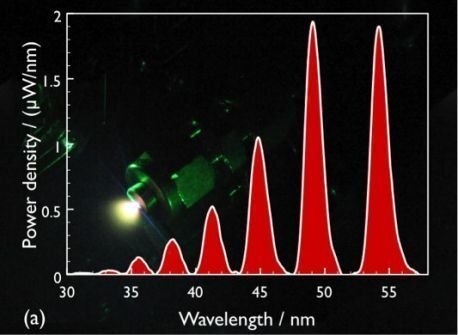High-Harmonic Generation
Recorded fiber laser driven HHG spectrum at high repetition rates.
Illustration: Univ. Jena, IAPHigh-harmonic generation (HHG) is a well-known process leading to the generation of very short-wavelength radiation in the extreme ultraviolet (10 nm to 100 nm) or even in the soft X-ray (0.1 nm to 10 nm) spectral range. It occurs during the interaction of intense laser pulses (~1014 W/cm2) with atoms or molecules, typically in a noble gas target. Due to the outstanding properties of the generated radiation, it has attracted a lot of attention. Not only the short wavelength, but also the coherence and the extremely short pulse duration make HHG an interesting tool for many different applications. Its spectrum consists of odd multiples of the fundamental frequency, which can be selected by a grating monochromator to obtain pulses at nearly arbitrary wavelengths. Besides the generation of attosecond pulses, it has found numerous applications in spectroscopy and imaging. Unfortunately, the process of high-harmonic generation exhibits very low conversion efficiencies. With commonly used Titanium-sapphire laser systems, this typically leads to a radiated average power of less than one microwatt. Thus, to date, most applications require long integration times to achieve a sufficient signal to noise ratio. Improving this situation requires a driving laser with much higher average power while maintaining the high peak power to reach the peak intensities required to stimulate the process.
-
Approach
Our approach is to use lasers with both high average powers and high peak powers. The fiber laser systems developed in our group ideally suits for this purpose. Delivering peak powers of more than 1 GW and repetition rates from 10 kHz to beyond 1 MHz. Depending on the wavelength coherent radiation with average powers of multiple picowatts (soft x-ray region) up to one milliwatt (at 60 nm) can be generated. This coherent high photon flux enables lens-less imaging experiments in the XUV with record high resolutions. Besides that, the high repetition rate alone enables or at least improves several innovative applications. For example, time-resolved photoelectron spectroscopy at surfaces would greatly benefit from a high-repetition-rate HHG source, because space charge effects of the photoelectrons are reduced as opposed to a low repetition rate sources at same average power.
-
Key aspects
Key aspects of our research are the further development of fiber laser technology to even higher average powers, the investigation of pulse shortening schemes to increase peak power and the development of innovative interaction schemes to optimize the frequency conversion process.
-
Selected publications
[1] M. Gebhardt, T. Heuermann, R. Klas, C. Liu, A. Kirsche, M. Lenski, Z. Wang,
C. Gaida, J. E. Antonio-Lopez, A. Schülzgen, R. Amezcua-Correa,
J. Rothhardt, J. Limpert, "Bright, high-repetition-rate water window soft
X-ray source enabled by nonlinear pulse self-compression in an antiresonant
hollow-core fibre," Light Sci. Appl. 10, 36 (2021). link to journalExternal link[2] R. Klas, A. Kirsche, M. Gebhardt, J. Buldt, H. Stark, S. Hädrich, J. Rothhardt,
J. Limpert, "Ultra-short-pulse high-average-power megahertz-repetition-rate
coherent extreme-ultraviolet light source," PhotoniX 2, 4 (2021). link to journalExternal link[3] S. Hädrich, J. Rothhardt, M. Krebs, S. Demmler, A. Klenke, A. Tünnermann,
J. Limpert, "Single-pass high harmonic generation at high repetition rate and
photon flux", Journal of Physics B: Atomic, Molecular and Optical Physics, 49(17),
172002 (2016). link to journalExternal link[4] J. Rothhardt, S. Hädrich, J. C. Delagnes, E. Cormier, and J. Limpert, "High Average
Power Near-Infrared Few-Cycle Lasers," Laser Photonics Rev. 11, 1 (2017).
External link link to journalExternal link[5] J. Rothhardt, G. K. Tadesse, W. Eschen, J. Limpert, "Table-top nanoscale coherent
imaging with XUV light," J. Opt. (United Kingdom) 20, (2018). link to journalExternal link
[6] R. Klas, S. Demmler, M. Tschernajew, S. Hädrich, Y. Shamir, A. Tünnermann,
J. Rothhardt, J. Limpert, "Table-top milliwatt-class extreme ultraviolet high
harmonic light source," Optica 3, 1167 (2016). link to journalExternal link
[7] R. Klas, W. Eschen, A. Kirsche, J. Rothhardt, J. Limpert, "Generation of coherent
broadband high photon flux continua in the XUV with a sub- two-cycle fiber
laser," Opt. Express 28, 6188-6196 (2020). link to journalExternal link
